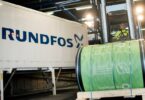A £30 million investment to help further protect the Blue Flag beaches in and around Bournemouth is nearing the finishing line.
Work on a major enhancement of the Dorset town’s primary water recycling centre near Holdenhurst village, which treats sewage from approximately 180,000 people throughout the area, is close to completion after more than 18 months of improvements.
New equipment at the site next to the A338 will enhance protection of the environment while ensuring the centre continues to meet the sewage treatment demands of Bournemouth’s growing population and the effects of climate change.
The Wessex Water investment, completed in conjunction with its sister engineering and construction company YTL Construction, was part of a £1.4 billion package of water and sewerage improvements that included a commitment to reduce overflow discharges and minimise the environmental impact of sewage treatment processes between 2020 and 2025.
Wessex Water’s 2025-30 business plan proposes more than doubling the £3 million a month spend to tackle storm overflows to £580 million across five years and investing a further £820 million to improve river and coastal water quality. It is currently being reviewed by the Competition and Markets Authority (CMA).
Programme Manager Joe Edmunds said: “This significant enhancement will ensure the Holdenhurst centre continues to properly store and treat sewage from Bournemouth, which sees a significant population increase during the summer tourism season.
“Our capacity to store excess water from sewers, which occurs during heavy storms when rain enters the system and mixes with foul water, has been expanded by 40 per cent, with an extra nine million litres of additional storage added within a new 2,275 metre square tank.
“Storing this excess water before returning to the network later for treatment will help to reduce storm overflows automatically releasing diluted untreated water back to the environment by nearly a third.’’
The two-year project also focused on removing more phosphorus and other nutrients from wastewater that can damage river and sea life.
Two treatment dosing units, holding more than 200,000 litres, to help reduce the impact of harmful nutrients found in wastewater. A further treatment process to help remove ammonia from wastewater is the largest single-unit installation of this type in the country.
Nutrients, such as phosphorus, ammonia and nitrogen can cause excessive growths of algae and damage the ecology of watercourses by reducing the oxygen in them.
Water quality at Dorset’s beaches is assessed by the Environment Agency, with most rated ‘Excellent’ – including Bournemouth Pier, Durley Chine and Alum Chine.
Wessex Water is also doing more towards the mission to improve water quality. With coastal and river water quality also affected by sources such as wildlife and agriculture, the company has developed an Artificial Intelligence (AI) app, with real-time monitoring at Bournemouth and Boscombe providing a better understanding of current water quality status, allowing people to make more informed decisions when bathing.
Wessex Water was also the first UK company to publish data on storm overflow operations at bathing waters and other recreational areas 365 days a year, and also provides this information to councils and Surfers Against Sewage. Visit wessexwater.co.uk/coastwatch
The education centre at the Holdenhurst site, which offers students and children the chance to visit the site and learn about the water treatment process, is also expected to restart visits from the start of the new academic year in September.
Further information about educational visits is available here.








